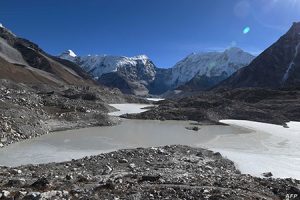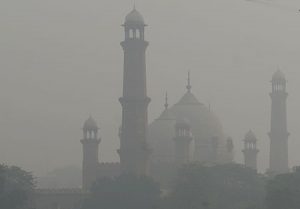While most of the world’s attention is focused on the Paris Climate Agreement’s mandate, requiring developed countries to reduce their carbon footprint, the developing regions are faced with a stark reality in the not too distant future. Collectively, developing countries will bear the greatest burden of confronting the serious impacts of climate change.
The South Asian region, home to almost 1.8 billion people, is particularly vulnerable. For many, life will be miserable and unbearable to the point of morbidity, with a sharp rise in heat and humidity, drought-like conditions in some parts, increased precipitation and widespread flooding in other areas, rising sea levels and coastal erosion in low-lying regions, along with higher incidences and intensities of typhoons and tropical storms.
In its long-term Climate Risk Index, Germanwatch placed Pakistan, Bangladesh and Nepal among the ten most susceptible countries to climate change, while India and Afghanistan are listed among the ten most climate-affected countries in recent years. According to a joint report by ActionAid International and Climate Action Network, more than 62 million people in South Asia will be driven from their homes by mid-century. Other estimates give a much higher regional migration figure, since in recent years nearly 700 million people have been displaced by climate-related events.

Probably the most disturbing feature of climate change and global warming in the South Asian region is the rapid decline of glaciers in the Himalayan-Karakorum and Hindu Kush mountains during the past forty years. Known as the “third pole,” these mountainous ranges contain one of the largest reservoirs of freshwater on the globe.
In recent years, loss of glacier mass has led to increased avalanches and landslides, along with numerous formation of glacial lakes in the region. Satellite pictures show thousands of newly formed glacial lakes dotting the mountainous landscape. Lately, the incidences of GLOFs (Glacial Lakes Outburst Floods) have greatly risen, causing considerable loss of life and property among those living at lower altitudes.
Of greater concern is that these mountain glaciers and snow cover provide the main sources of freshwater to major rivers and tributaries on the Asian subcontinent. Any permanent disruption of these water resources would have a devastating impact on agricultural productivity and power generation in the region. In a recent study by the London School of Economics, it was estimated that 129 million farmers depend on glaciers and snowmelt water on the Indus-Gangetic plain.
Although in terms of climate change, the future does not bode well on the subcontinent, the present day environment hardly lends itself to a high quality of life. For instance, air quality has greatly deteriorated during the past two decades in the South Asian region, with major cities and urban centres literally choking with polluted air during extended periods of the year.
Last year, 28 of the top 30 populated areas with the highest global particulate matter (PM2.5) levels were located in South Asia, with annual mean air concentrations ranging between 72 and 106 micrograms per cubic metre. These alarmingly high levels were some 7 to 10 fold above the World Health Organization’s PM2.5 guidelines of 10 micrograms per cubic metre. The major cities on the top list included Delhi and Lucknow in India, Lahore and Faisalabad in Pakistan, and Dhaka in Bangladesh.
There are a multitude of emission sources that contribute to high levels of particulate matter on the subcontinent. These include motor vehicle exhausts, industrial stacks, construction sites and biomass burning. Among them, the continuing use of domestic wood-burning stoves in rural areas is the most troublesome. Not only do they adversely affect the health of women and children residing indoors, their longer range environmental impacts are a significant cause of glacier melting at the present time.
Airborne particulate matter contains small-sized sooty material called black carbon that is transported long distances. Many recent studies have shown that the deposition of heat-absorbing black carbon in many regions of the globe, from Greenland ice sheets to the Himalayan Mountains, lead to rapid melting of glacier ice and snow packs. On the subcontinent, seasonal crop burning, household wood stoves, vehicular traffic and industrial pollution have combined to provide a witches brew of toxic air pollutants and rapid retreat of mountain glaciers all at the same time.

A number of scientific studies have shown that controlling the level of atmospheric particulate matter would result in a dual public health and environmental benefit in the South Asian region. That is, lowering particulate matter exposure would both improve human health and reduce water scarcity from loss of glacial freshwater sources. This would require a concerted effort to curb the use of domestic wood stoves, drastically reduce crop burning practices, and impose strict regulatory standards on motor vehicle emissions.
At present, national governments in the region have taken steps to lessen and mitigate the impact of climate change. For example, Pakistan has embarked on an ambitious carbon-capture and reforestation programme, with the goal of planting 10 billion trees across many parts of the country by 2023. Under the Paris Agreement framework, both Indian and Bangladeshi government officials have voiced their support to embark on a sustainable development pathway, by reducing their carbon footprint and increasing their investments in renewable energy.
However, it is not entirely clear how taking such step-wise mitigation efforts at the national level addresses the bigger question of the potential impact of climate change on the region. Although taken together, the three largest countries in the region, India, Pakistan and Bangladesh, account for 7.6 per cent of global carbon dioxide emissions at the present time, their historical CO2 emissions are less than 3.5 per cent. This is based on CO2 cumulative emissions data collected since the industrial revolution by the Oxford Martin School, a research institute at Oxford University.
On the other hand, what is not widely known, historically the United States and the European Union countries account for 51 per cent of global CO2 emissions, followed by China (12.7 per cent), Russia (6 per cent) and Japan (4 per cent). Once it is emitted, CO2 resides in the atmosphere from decades to several hundreds of years. In other words, because of carbon dioxide’s longevity, the industrialised countries in Europe and East Asia are responsible for nearly three-quarters (73.7 per cent) of the current global climate change impact.
At the 2010 UNFCCC (United Nations Framework Convention on Climate Change)-sponsored Climate Change Conference of the Parties meeting held in Cancun, Mexico (COP-16), the Green Climate Fund (GCF) to address climate change impacts was formally established. Even though a target of raising $100 billion by 2020 was agreed upon, that goal has not been reached. Only about one tenth of that original funding goal has been obtained or pledged up to now. This failure was partially blamed on leaving the matter of funding sources on vague and imprecise grounds. Thus, developed countries have not met their financial obligations in a timely manner. Additionally, there continue to be disputes concerning the role of private sources of funding within the GCF.
As originally conceived, the GCF was viewed as an international funding agency to assist developing regions in combating the impacts of climate change. Of greater importance are its grants to fund adaptation projects and build community resilience in countries most impacted by climate change and global warming. This includes many highly vulnerable communities in the South Asian region, that have been repeatedly dislocated and forced to leave their homes by extreme weather events in the past decade.
It is therefore imperative that delegates to the upcoming COP-26 meeting in Glasgow, UK, take up the issue of chronic shortage of climate adaptation funds within the UN system. This will require strengthening the hands of GCF in carrying out its original mission. Nothing short of repairing and shoring up the present funding mechanism will suffice for millions of inhabitants affected by the ravages of climate change.

The Writer is the Founder/Director of the Global Council on Science & Environment (GCSE) based in Washington D.C.

